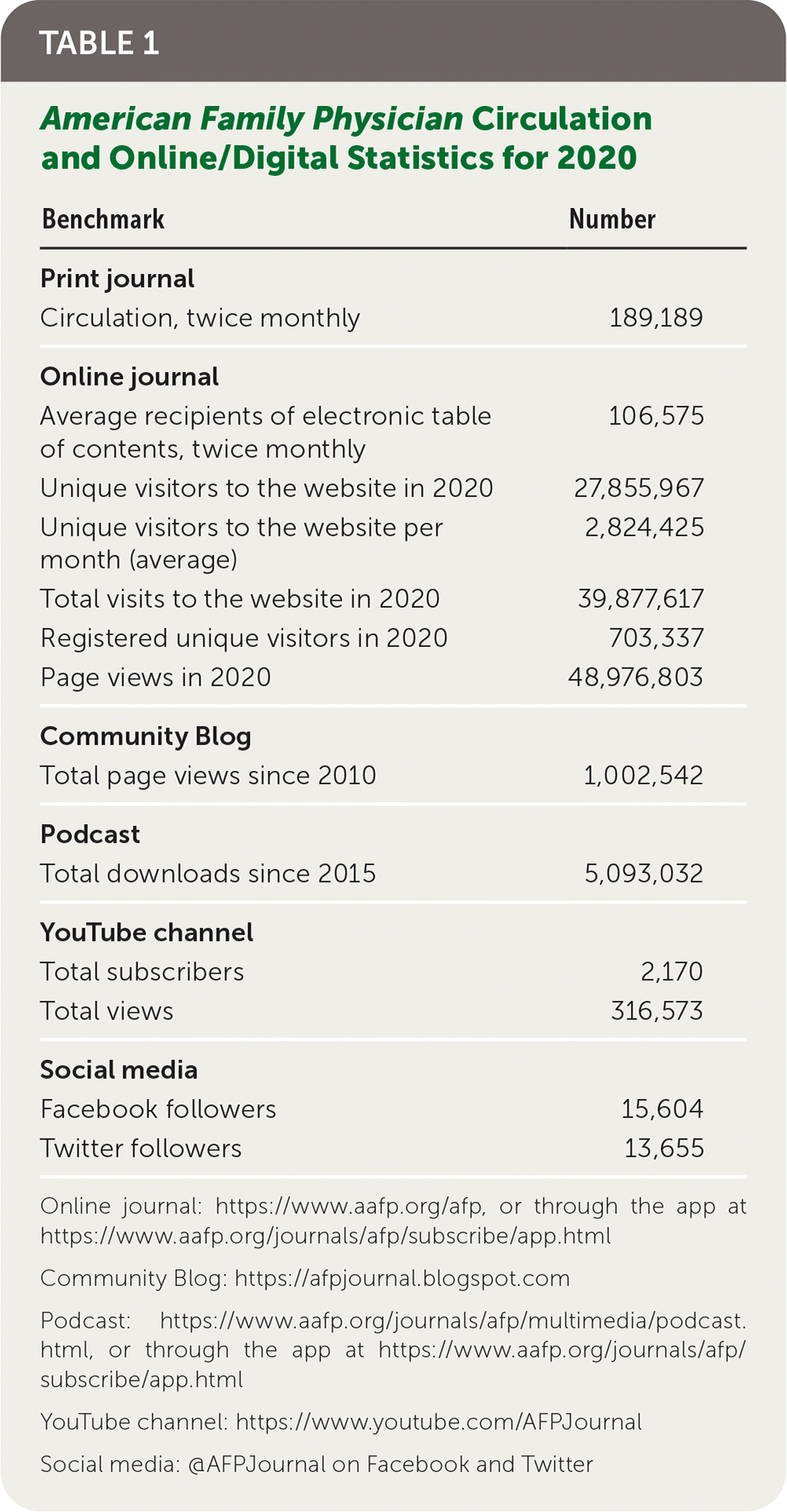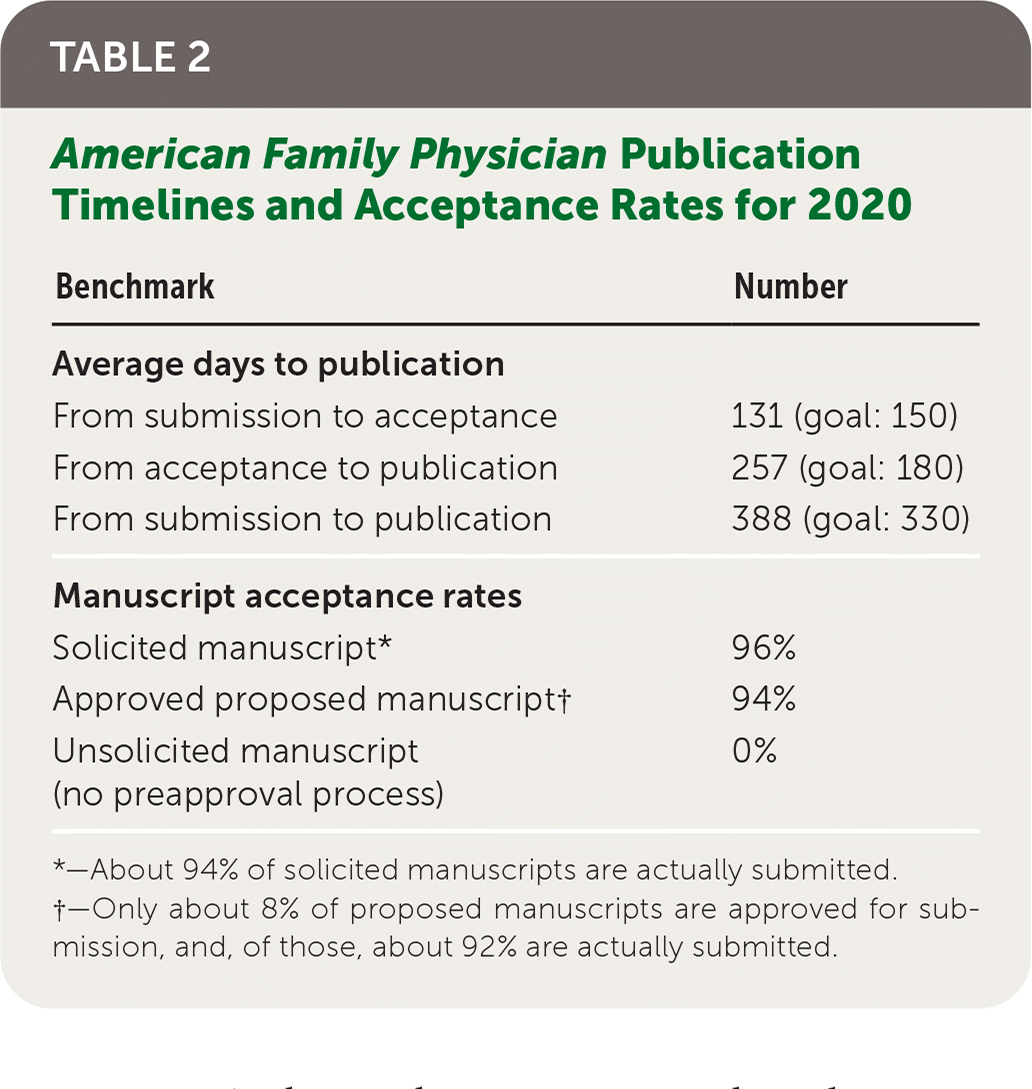
Am Fam Physician. 2021;103(12):716-718
Author disclosure: No relevant financial affiliations.
Diversity, Equity, and Inclusion
AFP is very pleased to have the insights of Dr. Renée Crichlow, chief medical officer of Codman Square and incoming vice chair of health equity for Boston University's Department of Family Medicine, in her role as our medical editor for diversity, equity, and inclusion (https://afpjournal.blogspot.com/2021/01/introducing-dr-renee-crichlow-afps.html). Dr. Crichlow and I have been working together with a team—medical editors, Drs. Chris Bunt, John Delzell, and Kenny Lin; professional editor, Amber Randel; and student representative, Dr. Priscilla Auguste—to reevaluate our curriculum and processes to better address racism and health inequities.
Last year, AFP's entire editing team endorsed an action plan that can be found on our website at https://www.aafp.org/journals/afp/content/diversity.html. We recognize that there are many passionate and often disparate views on racism and health equity. Our intent is to provide education and promote an effective dialogue. As family physicians, it is critical to evaluate the evidence around health equity and encourage more research so that we can provide meaningful paths to better care for all of our patients.
The mission of AFP remains unchanged: to be the leading source of high-quality, evidence-based clinical information for family physicians. However, a newly added core goal is to advance health equity and to highlight and support scholarship and continuing medical education about social determinants of health, health disparities, antiracism, and social justice (https://www.aafp.org/journals/afp/about.html). Not only are we increasing content on these topics, we are exploring ways to mentor underrepresented minorities in medical editing, reviewing, and writing and to collaborate with members of minority physician organizations and medical journals. We see these new efforts as necessary to achieve our core mission of integrating health equity into our content and processes.
Jay Siwek Medical Editing Fellow
The AFP team welcomes Dr. Jorge Finke as the 2021–2022 Jay Siwek Medical Editing Fellow. Dr. Finke completed medical school and residency at the University of Massachusetts and is a family physician at Bowdoin Street Health Center in Dorchester, Mass. You can read more about his background and interests in the AFP Community Blog at https://afpjournal.blogspot.com/2021/05/introducing-2021-2022-afp-jay-siwek.html.
In addition to fellows, AFP also has resident and student representatives who help with various projects throughout the year. They typically serve annual terms that begin in January and end in December, with the selection process for new representatives starting again in the summer. We are lucky to have the enthusiasm of Dr. Kento Sonoda of the University of Pittsburgh Medical Center Shadyside Family Medicine Residency Program and recent medical school graduates, Dr. Priscilla Auguste of Ross University School of Medicine and Dr. Phoebe Hughes of Florida International University Herbert Wertheim College of Medicine. To learn more about these positions, go to https://www.aafp.org/afp/residentrep and https://www.aafp.org/afp/studentrep.
AFP's Top 20 Articles of 2020
Don't miss the top 20 AFP articles that were most viewed by readers online last year (https://www.aafp.org/journals/afp/content/top-articles.html). Not surprisingly, the most viewed article was “Outpatient Management of COVID-19: Rapid Evidence Review,” which was published in the October 15, 2020, issue and updated online in March 2021.4 This is the first time that AFP has published an article with a plan for updating it as new evidence emerges. Other popular article topics from last year include combination therapy for hypertension, acute chest pain, dyspepsia, neck pain, tickborne diseases, fever in infants and children, headaches, gout, point-of-care ultrasonography, and several others reflecting the broad scope of primary care. Our goal is to highlight all of these topics in AFP Clinical Answers (http://www.aafp.org/afp/answers).
A collection of the top 20 research studies for primary care physicians, the top 20 POEMs, and the top 20 POEMs consistent with the principles of the Choosing Wisely Campaign can be found at https://www.aafp.org/journals/afp/authors/ebm-toolkit/resources/top-poems.html. The “Top 20 Research Studies of 2020 for Primary Care Physicians” article is available online ahead of print at https://www.aafp.org/afp/grad.html.
Circulation and Website Statistics
The circulation of AFP's print journal is 189,189 (Table 1). To the best of our knowledge, AFP has the second-largest circulation of any medical journal, based on the evaluation of an independent publication auditing firm.5 Print circulation includes all 72,700 active members of the American Academy of Family Physicians (AAFP), approximately 40,000 nonmember family physicians, and approximately 50,000 general internists. AFP has consistently been rated the number one journal among primary care physicians.6

| Benchmark | Number |
|---|---|
| Print journal | |
| Circulation, twice monthly | 189,189 |
| Online journal | |
| Average recipients of electronic table of contents, twice monthly | 106,575 |
| Unique visitors to the website in 2020 | 27,855,967 |
| Unique visitors to the website per month (average) | 2,824,425 |
| Total visits to the website in 2020 | 39,877,617 |
| Registered unique visitors in 2020 | 703,337 |
| Page views in 2020 | 48,976,803 |
| Community Blog | |
| Total page views since 2010 | 1,002,542 |
| Podcast | |
| Total downloads since 2015 | 5,093,032 |
| YouTube channel | |
| Total subscribers | 2,170 |
| Total views | 316,573 |
| Social media | |
| Facebook followers | 15,604 |
| Twitter followers | 13,655 |
The AFP website received an average of 2.8 million unique visitors per month (attributable to a unique browser or device) in 2020, making it one of the most popular online medical publications. This means that in addition to visits by almost all AAFP members, the website is viewed by millions of other health care professionals and those who presumably are seeking information about various clinical conditions. Additionally, about 480,000 of the journal's CME quizzes have been taken annually since 2017, and approximately 2.8 million credits were awarded in 2020. Of note, beginning with the July 2021 issue, our CME quizzes will be eligible for CME credit for two years from the publication date.
Publication Timelines and Acceptance Rates
On average, review articles are accepted a little under five months after they are submitted, which allows time for peer review and medical editing (Table 2). Articles are typically published eight to nine months after acceptance. A lot goes into the selection of articles for each issue to provide readers with a mix of topics. Articles that go online ahead of print are typically published online about four months after acceptance. In 2020, we published 12 articles online ahead of print. So far in 2021, we have published four articles online ahead of print.

| Benchmark | Number |
|---|---|
| Average days to publication | |
| From submission to acceptance | 131 (goal: 150) |
| From acceptance to publication | 257 (goal: 180) |
| From submission to publication | 388 (goal: 330) |
| Manuscript acceptance rates | |
| Solicited manuscript* | 96% |
| Approved proposed manuscript† | 94% |
| Unsolicited manuscript (no preapproval process) | 0% |
To ensure comprehensive coverage of a curriculum of topics, we solicit most of the articles that are published. We may ask a previous author to update their article, and we also circulate a “call for papers” through multiple family medicine communication platforms. Our preference is for the first author to be an experienced clinician and writer because our readership largely comprises busy physicians who rely on AFP for practical, evidence-based content and CME. However, we encourage experienced authors to mentor coauthors, especially authors from groups that are underrepresented in medicine to increase diverse authorship.
Authors who propose unsolicited topics go through a formal approval process before submitting a manuscript for consideration. They are strongly encouraged to read the AFP Authors' Guide (https://www.aafp.org/afp/authors) before contacting us.
Roughly 8% of proposed topics are approved. When they are not approved, it is often because the topic has already been covered or does not fit the AFP curriculum. For solicited and approved proposed topics, AFP editors provide authors with detailed guidance on the focus of the article. For these reasons, the acceptance rate for solicited manuscripts and approved proposals is high at 96%.
An important change to note regarding publication is that, starting next month, AFP will be published 12 times a year instead of 24, which translates to healthier-sized issues and savings on production and mailing. We recently surveyed readers about publishing fewer issues, and most viewed this as a positive change overall. The amount of content and CME produced will not change, and CME credit will be available for 24 months instead of 12 months, which allows a little extra catch-up time.
Acknowledging Peer Reviewers
Peer review continues to be an essential and valuable process for the journal, and we are very appreciative of the work reviewers do in helping us develop sound content for AFP. This is the third year that we are recognizing all peer reviewers for volunteering their time in addition to highlighting reviewers who provided exceptional feedback (https://www.aafp.org/journals/afp/reviewers/peer-reviewers/2020.html). An archive of past AFP peer reviewers is available at https://www.aafp.org/journals/afp/reviewers/lists.html.
If you are interested in reviewing for AFP, please read the Reviewers' Guide (https://www.aafp.org/journals/afp/reviewers/guide.html), and complete a reviewer profile. For new reviewers, we highly recommend that you find a mentor for your first review, which could include senior physicians with authorship experience, department chairs and faculty, and residency directors. Drs. Drowos and Pyzocha, AFP's 2020 editorial fellows, created a video to explain how to complete a critical and thorough review, which can be found in the Reviewers' Guide. The AAFP has authorized CME credit for AAFP members who peer review manuscripts for journals (https://nf.aafp.org/Cme/Reporting/ClaimCredit.aspx).
We remain grateful to our dedicated readership and to the authors, editors, and reviewers who have paved the way for AFP to be the best-read journal in primary care. As always, to help us better meet your needs, we welcome reader feedback, which can be emailed to afpjournal@aafp.org.
Editor's Note: Dr. Sexton is editor-in-chief of AFP.
